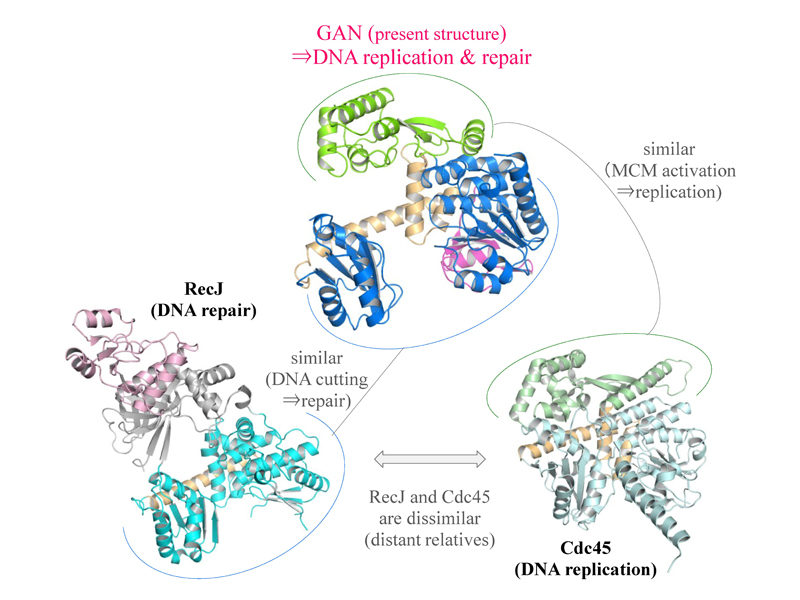A structural biology study on proteins for DNA replication (conducted by Dr. Takuji Oyama, Faculty of Life and Environmental Sciences) was published into an international scientific journal “Nucleic Acids Research”
Dr. Takuji Oyama, an Associate Professor in Department of Biotechnology, Faculty of Life Environmental Sciences, in collaboration with Kyushu University (Professor Yoshizumi Ishino’s laboratory) and Nagahama Institute of Bio-Science and Technology (Prof. Tsuyoshi Shirai’s laboratory), has revealed the three-dimensional structure of a unique protein called GAN, which works for DNA replication, at atomic level. The research paper has been published into an international scientific journal “Nucleic Acids Research”.
Journal
Nucleic Acids Research, Advance Access at September 5, 2016
The website of “Nucleic Acids Research”
Title
Atomic structure of an archaeal GAN suggests its dual roles as an exonuclease in DNA repair and a CMG component in DNA replication.
Authors
Takuji Oyama, Sonoko Ishino, Tsuyoshi Shirai, Takeshi Yamagami, Mariko Nagata, Hiromi Ogino, Masami Kusunoki and Yoshizumi Ishino
Note: Dr. Masami Kusunoki, an Professor in Department of Biotechnology, Faculty of Life Environmental Sciences, University of Yamanashi.
Outline
In the early stage of DNA replication in Eukarya, including human being, a protein called MCM helicase unwinds the parental double-stranded DNA to two single-stranded DNAs. Then the complementary strand is newly synthesized for each of the unwound strands so that DNA is replicated. It has been found that MCM is activated by two protein factors called Cdc45 and GINS, but the detailed mechanism how MCM unwinds DNA with the help of Cdc45 and GINS is unknown.
Here the Dr. Oyama’s research group targeted a protein called GAN, which is involved in archaeal DNA replication system and considered to have a similar role to the eukaryotic counterpart Cdc45, and analyzed its three dimensional structure by X-ray crystallography. GAN has been known as a DNA cutting enzyme working for DNA repair system, but the present structural study showed that GAN have a very unique “hybrid” structure which indicates that GAN can work both in DNA repair and in DNA replication.
- The three-dimensional structure of the archaeal GAN protein (center) and comparison with the related proteins RecJ (left) and Cdc45 (right). GAN exhibits a “hybrid” structure which contains both the RecJ and Cdc45 related regions onto one protein. Then GAN could possess dual roles as a DNA cutting enzyme in DNA repair and the MCM activator, the component of the helicase holo-enzyme complex, in DNA replication
For more details, please visit the website of Faculty of Life and Environmental Sciences.
(Japanese version only, but it contains more informative pictures about this study.)


